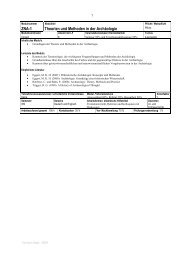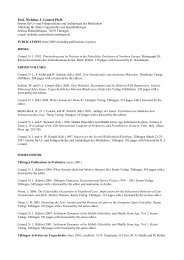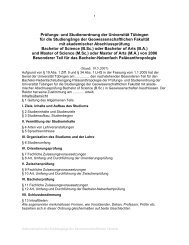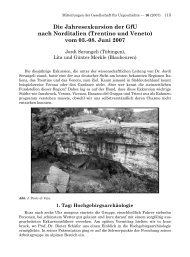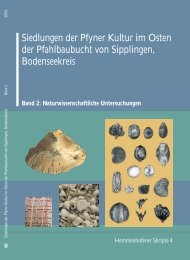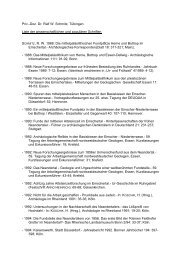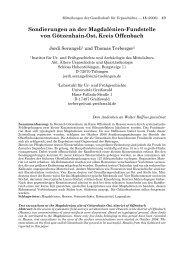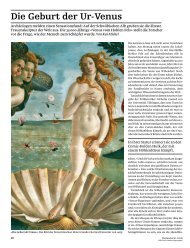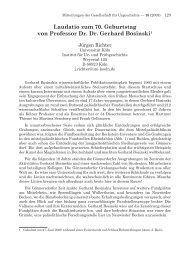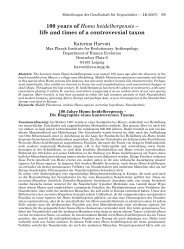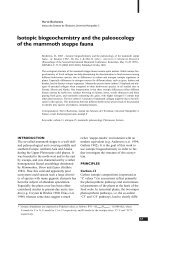bronze age environment and economy in the troad - Universität ...
bronze age environment and economy in the troad - Universität ...
bronze age environment and economy in the troad - Universität ...
Create successful ePaper yourself
Turn your PDF publications into a flip-book with our unique Google optimized e-Paper software.
chapter 1: <strong>environment</strong> <strong>and</strong> archaeology<br />
Aegean Polis, but ra<strong>the</strong>r <strong>in</strong> <strong>the</strong> model of “old oriental Palatial<br />
Cities” or Near Eastern “residence <strong>and</strong> trade towns”, such as<br />
Alişar, Kültepe or Hattusa (also Karahöyük, Açemhöyük,<br />
Maşat Höyük). The periods Troy VI <strong>and</strong> Troy VII are named<br />
by Korfmann (1996) as <strong>the</strong> ‛Troian High Culture’.<br />
Troy VI <strong>and</strong> VIIa do not show differences <strong>in</strong> <strong>the</strong> material culture<br />
<strong>and</strong> only <strong>the</strong> architecture shows a slight change with<br />
smaller <strong>and</strong> differently spaced rooms. Differences <strong>in</strong> build<strong>in</strong>g<br />
techniques <strong>in</strong> Troy VI (i.e. <strong>the</strong> post build<strong>in</strong>gs of <strong>the</strong> lower city)<br />
are <strong>in</strong>terpreted as social differences with<strong>in</strong> <strong>the</strong> population. The<br />
end of Troy VI was <strong>in</strong>terpreted <strong>in</strong> <strong>the</strong> earlier excavations as<br />
caused by an earthquake, but this might be under question <strong>in</strong><br />
view of <strong>the</strong> f<strong>in</strong>ds of long-range weapons <strong>in</strong> <strong>the</strong> new<br />
excavations.<br />
Troy VII domestic architecture was excavated <strong>in</strong> trench E8. In<br />
this area 13 of <strong>the</strong> 16 botanical samples were extremely rich.<br />
Also <strong>in</strong> z7 Troy VII architecture with large stone foundations<br />
were found. Only two samples could be used for statistical<br />
analysis. The samples <strong>in</strong> <strong>the</strong>ir archaeological contexts are discussed<br />
<strong>in</strong> chapter 3.<br />
The trenches z6-8 <strong>and</strong> A7-8 were excavated from 1994 on a<br />
larger scale <strong>and</strong> uncovered more Late Bronze Age domestic<br />
architecture. Several rooms were sampled, with 21 samples<br />
from ma<strong>in</strong>ly Troy VIIa layers.<br />
Periods VIIb1-3 (4) are named by Korfmann (1996) as <strong>the</strong><br />
“Troian Culture with <strong>the</strong> impr<strong>in</strong>t of Balkan <strong>in</strong>fluences”, which<br />
ma<strong>in</strong>ly refers to <strong>the</strong> ‛Knobbed ware’. A Troy VIIb2 house with<br />
two build<strong>in</strong>g phases was excavated <strong>in</strong> 1995 <strong>in</strong> <strong>the</strong> trenches of<br />
E8. The older build<strong>in</strong>g was destroyed by fire dur<strong>in</strong>g <strong>the</strong> general<br />
conflagration of Troy VIIb2. The newly erected build<strong>in</strong>g conta<strong>in</strong>ed<br />
imported protogeometric pottery amongst <strong>the</strong> f<strong>in</strong>ds.<br />
Ano<strong>the</strong>r build<strong>in</strong>g <strong>in</strong> E9, belong<strong>in</strong>g to Troy VIIb3 (latest phase<br />
of Troy VIIb) was also sampled. Altoge<strong>the</strong>r, 33 samples were<br />
taken from <strong>the</strong>se contexts, discussed <strong>in</strong> chapter 3. The follow<strong>in</strong>g<br />
three centuries appear to be of sparse settlement. The f<strong>in</strong>d<br />
of a seal, dat<strong>in</strong>g around 1100 (i.e. <strong>the</strong> Dark Ages) with Luwian<br />
hieroglyphs, which might have belonged to a writer,<br />
streng<strong>the</strong>ns Korfmann’s assumption that Troy was culturally<br />
oriented towards Anatolia dur<strong>in</strong>g <strong>the</strong> whole second millennium<br />
(Korfmann 1996).<br />
1.2.2.3.4 Post-Bronze Age (Troy VIII/IX)<br />
The <strong>in</strong>vestigation of <strong>the</strong> Troy VIII <strong>and</strong> IX horizons has been<br />
conducted by Brian Rose <strong>and</strong> his team from <strong>the</strong> University of<br />
C<strong>in</strong>c<strong>in</strong>nati (Rose 1991, 1992, 1993, 1994 <strong>and</strong> 1995a). Because<br />
<strong>the</strong> aim of this archaeobotanical study was to underst<strong>and</strong><br />
Bronze Age <strong>environment</strong> <strong>and</strong> <strong>economy</strong>, <strong>the</strong> later periods were<br />
not comprehensively studied. In all, 20 samples were taken,<br />
with five from Archaic horizons, three from Classical, eight<br />
from Hellenistic, <strong>and</strong> only four from Roman contexts. The<br />
results from <strong>the</strong> analysis of <strong>the</strong>se samples are only used here<br />
for comparative purposes. A detailed study of plant rema<strong>in</strong>s<br />
from Post-Bronze Age horizons is <strong>the</strong> aim of fur<strong>the</strong>r research.<br />
The focus of <strong>the</strong> Post-Bronze Age excavations <strong>in</strong> Troy is on a<br />
“detailed reconstruction of <strong>the</strong> religious history of <strong>the</strong> Greek<br />
<strong>and</strong> <strong>the</strong> Roman settlement” (Korfmann 1994, Rose 1992). This<br />
research focus evolved <strong>in</strong> correlation to Troy’s or Ilion’s<br />
political <strong>and</strong> religious status. After <strong>the</strong> Archaic period (700-<br />
480 BC), Ilion became <strong>the</strong> capital of a new league of Troad<br />
cities which was focussed on <strong>the</strong> cult of A<strong>the</strong>na Ilias.<br />
Alongside <strong>the</strong>se changes ostentatious build<strong>in</strong>gs were erected <strong>in</strong><br />
<strong>the</strong> early Hellenistic period (331-200 BC), such as <strong>the</strong> <strong>the</strong>atre<br />
A <strong>and</strong> <strong>the</strong> temple of A<strong>the</strong>na. In 85 BC <strong>the</strong> city was destroyed<br />
by <strong>the</strong> Roman legate Fimbria. With <strong>the</strong> rebuild<strong>in</strong>g shortly<br />
<strong>the</strong>reafter Troy IX (85 BC-500 AD) beg<strong>in</strong>s. Late Roman/Early<br />
Byzant<strong>in</strong>e habitation is now documented by excavations <strong>in</strong> <strong>the</strong><br />
Lower City, where an orthogonal plan of streets has been<br />
found by geomagnetic prospect<strong>in</strong>g (Rose 1992).<br />
Excavation of trenches <strong>in</strong> I/K 17/18 uncovered rema<strong>in</strong>s of<br />
build<strong>in</strong>gs, <strong>and</strong> <strong>in</strong> H16/17 a glass factory was found. Generally<br />
<strong>the</strong> botanical rema<strong>in</strong>s were badly preserved because of <strong>the</strong>ir<br />
position close to <strong>the</strong> surface. Only two samples from <strong>the</strong>se<br />
trenches provided enough rema<strong>in</strong>s to work on (H17BP07,<br />
I17BP07). The Post-Bronze Age excavations <strong>in</strong> <strong>the</strong> Lower City<br />
also show an apparent discont<strong>in</strong>uity of settlement between <strong>the</strong><br />
end of <strong>the</strong> Bronze Age (1050 BC) <strong>and</strong> <strong>the</strong> Middle Hellenistic<br />
period (c. 200 BC), at least <strong>in</strong> <strong>the</strong> excavated sections of <strong>the</strong><br />
Lower City (Rose 1993). Archaic <strong>and</strong> protogeometric pottery<br />
was found <strong>in</strong> <strong>the</strong> area of <strong>the</strong> sanctuary <strong>and</strong> might <strong>in</strong> future clarify<br />
<strong>the</strong> history of <strong>the</strong> population of Troy at <strong>the</strong> beg<strong>in</strong>n<strong>in</strong>g of <strong>the</strong><br />
first millennium BC (Rose 1994).<br />
The sanctuary, i.e. ma<strong>in</strong>ly <strong>the</strong> trenches <strong>in</strong> A8/9 <strong>and</strong> z6/7, has<br />
been excavated s<strong>in</strong>ce 1992. It was founded c. 700 BC, <strong>and</strong><br />
cont<strong>in</strong>ued <strong>in</strong> use through Archaic <strong>and</strong> Classical periods. It was<br />
completely rebuilt <strong>in</strong> early Hellenistic, like <strong>the</strong> o<strong>the</strong>r<br />
monumental architecture, <strong>and</strong> after Fimbria’s destruction it was<br />
rebuilt on <strong>the</strong> debris of <strong>the</strong> former constructions (Rose 1993).<br />
There are three altars from different periods <strong>in</strong> <strong>the</strong> Upper<br />
Sanctuary <strong>and</strong> two additionally <strong>in</strong> <strong>the</strong> Lower Sanctuary. Seven<br />
archaeobotanical samples from <strong>the</strong> Sanctuary conta<strong>in</strong>ed a<br />
relatively large number of seeds.<br />
1.2.3 Comparative summary of <strong>the</strong> results from Blegen’s <strong>and</strong> Korfmann’s excavations<br />
12




